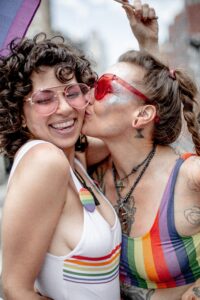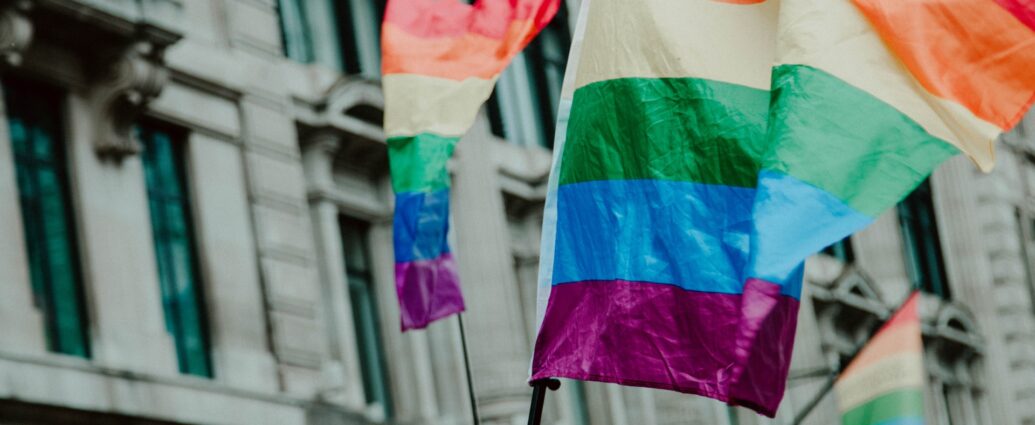Samantha Lewis
A record number of 1.5 million people turned up on Saturday 2 July to celebrate five decades of Pride since the first march in 1972. Over 600 LGBTQ+ groups—comprising 30,000 people overall—took part in the march, led by original members of the Gay Liberation Front from the initial protest.
Revellers wearing face paint, glitter and sequins joined the colourful march that followed a similar route, running from Hyde Park Corner to Whitehall Palace, passing significant sites from the UK’s LGBTQ+ movement.
London Mayor Sadiq Khan hailed it a “beautiful day” of “unity, visibility, equality and solidarity”
After being postponed for two years due to Covid, London Mayor Sadiq Khan hailed it a “beautiful day” of “unity, visibility, equality and solidarity” as he joined in the celebrations. Organisers called the event the “biggest and most inclusive event in history”, and featured a line-up of artists performing across four stages around Central London.
The original march followed a demand for visibility and equality against a backdrop of lingering prejudice, discrimination and fear amongst many queer individuals about coming out.
Who attended London Pride 2022?
Singer Emeli Sande, who came out publicly in April, was among those on the entertainment line-up. Eurovision-winner Netta, Kat Graham and Samantha Mumba also featured, with pop star Ava Max closing the show on the Trafalgar Square stage.
I would like you all to say with me “freedom is my voice”
Floats lined Park Lane ahead of the main march through the capital, led by Gay Liberation Front activists holding placards reading “I was there in 1972”.
Olympic great, Dame Kelly Holmes joined the march and told the crowd at Trafalgar Square she would “never live behind that curtain again”, after coming out as gay last month.
“For 34 years I have never been able to say those words until two weeks ago, due to the fear of judgement and retribution that was instilled in me since the age of 18 because of the laws in the military and being in the public eye”, she admitted to the crowd. “As I said at the Pride Awards last week, freedom is my voice. I would like you all to say with me ‘freedom is my voice’”, leading to a powerful moment of joint chanting.
Broadcaster Philip Schofield also attended, as did Labour MP and Deputy Leader of the Labour Party, Angela Rayner.
https://twitter.com/POLITlCSUK/status/1543246080917340162?s=20&t=iLVA7NpaZEhYJbggJ5Eo4Q
Also marching were reality stars Matthew Jameson and Daniel McKee who found fame on the hit Channel 4 show Married at First Sight, after becoming the first gay couple to participate. As well as the stars of the hit Netflix show Heartstopper who stood up to anti-LGBTQ+ protestors by dancing and singing in front of them.
A Brief History
Each year, the entirety of June is dedicated to Pride in many countries around the world, marking a season for celebrating LGBTQ+ identities and raising awareness of the social and political inequalities surrounding sexuality and gender identity.
The first Pride rally took place on July 1 1972, the nearest Saturday to the anniversary of the Stonewall riots of June 28 1969.
Hundreds resisted prejudiced arrest, and a mirror was smashed by “the shot glass that was heard around the world”
In 1969, eight police officers from the New York ‘Public Morals Division’ raided the Stonewall Inn, a gay bar in Greenwich Village, during the early hours. There was nothing particularly exceptional about this. In the sixties, the NYPD unit enforced all ‘vice’ laws and had the power to arrest and hospitalise LGBTQ+ individuals by force.

Though it was a regular ordeal, on this particular night the bar fought back; hundreds resisted prejudiced arrest, and a mirror was smashed by “the shot glass that was heard around the world”, thrown by black transgender activist Marsha P. Johnson. As the eight policemen barricaded themselves inside the Stonewall Inn, protesters took control of the street for the next five nights.
In the 1980s, ‘Gay Freedom’ became ‘Gay Pride’, and from 2009 to 2016 President Obama officially declared June the month of LGBTQ+ Pride. Only five years after homosexuality was decriminalised in the UK, several hundred people took part in the first march. Pride in London says it will honour “our evolution as a movement; acknowledging those torch bearers who have come before us and their achievements”.
“As we celebrate and look forward to the next 50 years, we’ll recognise the challenges still faced by our community nationally and globally”.
Featured image courtesy of daniel james on Unsplash. Image license found here. No changes were made to this image.

